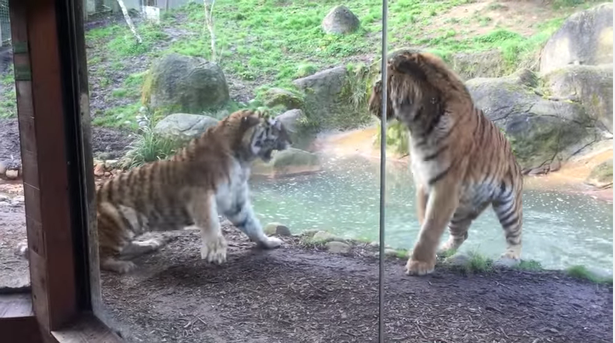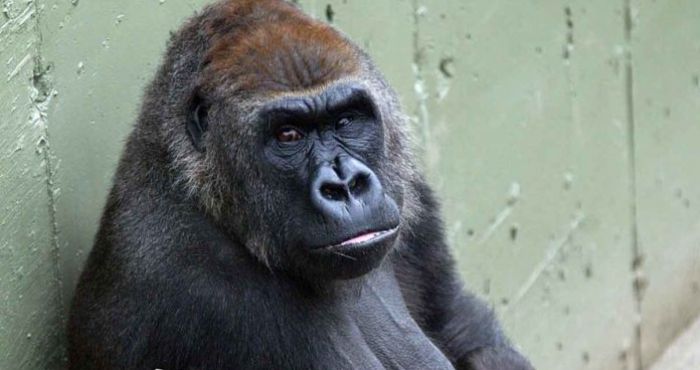- [email protected]
- National Animal Rights Association, Suite 10684, 26/27 Upper Pembroke Street, Dublin 2, D02 X361.
Zoos do nothing to help animals. They only exist as a source of entertainment for people.

Of the 5,926 species (mammals, birds, reptiles and others) classified as threatened or endangered by the International Union for the Conservation of Nature, only around 120 species are involved in international zoo breeding programs, and from these just 16 species have been reintroduced to the wild – often unsuccessfully.
A lot of captive-bred animals lack survival skills, and as a result, some reintroduction projects have had to be suspended indefinitely. Releases of captive animals also pose a significant disease threat to native populations. In some cases, reintroductions have been cancelled after discovering viruses in captive-bred populations that were due to be released in areas where the virus was unknown; in others, native animals have died because of viruses spread by introduced animals.
Zoos only divert funds that could be used to actually help and save animals in the wild. It is estimated to be 50 times more expensive to keep an elephant in a zoo than to protect sufficient natural habitat to sustain that elephant and many other animals. The costs, both financial and to the animals themselves, of captive breeding conservation programmes are astronomically high. Money could be better, and more ethically, spent establishing protected reserves, funding anti-poaching patrols and lobbying for legislation to protect wildlife.
What can possibly be gained from watching an animal locked up in an enclosure? Do you think they’d prefer this to being free in their natural habitats and native countries?

Most animals kept in zoos are there just to draw in the tourists. Lions are popular ‘exhibits’ in zoos, but according to an international zoo journal, the vast majority of the lions “are ‘generic’ animals of hybrid or unknown sub-specific status, and are therefore of little or no value in conservation terms.” Zoos even still take animals from the wild!
Throughout the 1990s over 1,000 elephants were taken from the wild and sold to zoos and circuses, and over 70% of elephants in European zoos today were wild-caught.
Don’t be fooled by the lies spun out by zoo officials. If they really cared about animals, they wouldn’t be doing this to them.

Zoos do nothing to promote respect or appreciation for animals. In fact, they do quite the opposite. Trips to zoos leave children, and adults, with a distorted view of animals and how they should be treated. A study of zoo-visitor attitudes found that, after people saw animals in zoo enclosures, they had “a significantly greater negative and dominionistic attitude towards animals.”
In the wild, animals react to their surroundings, avoiding predators, seeking food and interacting with others of their species. These animals would also normally roam for tens of miles a day, but instead they are reduced to circling their pens. It is so common for big cats to constantly pace up and down their enclosure that zoos put concrete paths along the fence to stop the ground wearing down.
What might seem to be ‘larger’ or ‘better’ enclosures are, in reality, completely impoverished in terms of the animals’ real needs. Space in zoos do nothing to match the animals’ natural range. A study of zoos worldwide found that lions and other big cats have 18,000 times less space in zoos than in the wild, and that figure rises to one million times less space for captive polar bears. For fifteen hours a day, many animals may be shut away in their night quarters with even less room to move.
Even their diets are unnatural. Zebras in zoos become overweight, as the grass they are given is higher in calories than the grasses of the African savannah. The resulting obesity can make the animal susceptible to nutritional illness.
Frustration and boredom are commonplace amongst animals in zoos and can lead to obsessive behaviours in the form of repetitive movements such as pacing, swaying, and even self-mutilation. This is known as stereotypic behaviour. With nothing to do, animals
in zoos go out of their minds. Studies have found that lions in zoos spend 48% of their time pacing and 40% of elephants performed stereotypic behaviours.


Some animals suffer such serious behavioural problems in zoos that they are given antidepressants, tranquillisers and anti-psychotic drugs to control their behaviours. Even Dublin Zoo was caught giving animals drugs such as prozac and valium.
Zoo enclosures prevent the inmates from enjoying even their most basic behavioural repertoire including exercise and social interaction. Birds are virtually stripped of their most precious gift, flight, often able to do little more than flutter their wings. Consequently, birds in zoos are prone to arthritis and osteoporosis. However, it is not just a matter of space, but also the quality of the environment.
Chimpanzees are our closest relatives in the animal kingdom, their intelligence is universally accepted, but they exchange the infinite possibilities of the forest for little more than playground climbing frames which would not keep a human child occupied for hours, let alone years. Reptiles need complex thermal ranges, variation in humidity, special phases of light and other factors that may seem difficult for us to appreciate as humans.
Zoos rarely have the numbers to match the natural social interaction of herd animals. And when animals do find company, their world may be torn apart when cage mates are sold or become excess to requirements.
Did you know that zoos actually over-breed animals? The sad truth is that in many zoos, animals are bred simply to attract visitors and then pressure on space and resources means that a lot of them will be disposed of or killed at the end of the season.

It is estimated that at least 7,500 individual animals in European zoos are ‘surplus’ at
any one time. What do they do with the ‘surplus’ that they don‘t kill? They sell these poor animals to circuses, vivisection laboratories, exotic meat farms and the ‘pet’ trade. An undercover investigation revealed that even Dublin Zoo sold animals to the Chipperfield’s Circus (who are convicted animal abusers).
Zoos only serve to degrade, exploit and abuse animals that should be free. What gives
us the right to enslave these animals, just because we find it entertaining to stare at
them?
If you love animals, don't go to the zoo!
FACTSHEET - Dublin Zoo in the Headlines: A Hidden Past of Abuse
1994:
- Zookeeper of 10 years Brendan Price quits in protest of the animals’ living conditions.
- The two resident Polar bears are mentally ill (they have been at the zoo for 17 years).
- Adult male hippo kept inside with a tiny ‘bath’ - separated from female and baby hippo, who get to go outdoors. In winter, the male will be kept in a different pen, with just a running hose to stand under.
- Elephants locked out of indoor enclosure during zoo open hours - so they are constantly on display.
- Animal rights groups call for independent inquiry after the death of a Sea Lion.
- No hiding place for wolves to get away from the public eye - kept on display at all times.
- Dublin Zoo will not release their animal records - which would document how many animals have been born, bred, imported, exported, or have died there every year.
1995:
- Pregnant Gibbon dies days after Orangutan tested positive for tuberculosis.
- Sea Lions are kept in chlorinated water - as a result some suffered from keratitis which then progressed to blindness.
- Report commissioned by the ISPCA says many of the animals in Dublin Zoo are bored, stressed, withdrawn and in urgent need of stimulation.
1996:
- Animal rescue organisations “Animal Rescue” and “Bear With Us” offer to pay (and provide a home) in Canada for the Zoo’s two Polar bears. This follows an animal cruelty investigation and Gardai report sent into the DPP on the mistreatment of the bears. Zoo director says the Polar bears will ‘not be withdrawn from the zoo’ as they intend to build a bigger enclosure.
1997:
- A White Rhino (which is an endangered species) was shot dead while being loaded on a truck to go to Longleat Safari Park (owned by Chipperfield’s Circus). Zoo staff say the rhino died ‘almost instantly’.
- 11 Penguins die from food poisoning.
1998:
- Dublin Zoo admits to giving Prozac and Valium to the animals to ‘encourage them to interact’.
- A Macaw is stolen after a break-in at the zoo.
1999:
- An undercover investigation on the Chipperfield’s Circus and Farm (they are a notorious, and convicted, family of animal abusers in the UK) revealed that Dublin Zoo had been supplying them with animals - such as camels, hippos, tigers and lions - for years. Why? Because Dublin Zoo can’t fit all the animals that they breed every year.
2000:
- A wolf was shot dead - because he ‘tried to escape’ - and 8 wolf cubs were put down, as the zoo had no room for them.
- 25 prairie dogs were killed - some from eating rat poison and burrowing into the cheetahs enclosure. When the rest did not surface from their burrows, the area was bulldozed as it was under renovation. Zoo staff ‘believe none were present’ at the time.
- A Scarlet Macaw (an endangered species of parrot - on ‘loan’ from Britain’s Twycross Zoo) was given to a private collector and told that he could keep the bird indefinitely. Dublin Zoo claim the bird ‘would be returned if required’.
- A mother and baby chimp (on ‘loan’ from Belfast Zoo) drowned in the new island exhibit, while trying to rescue another chimp which had fallen into the water. The baby got an electric shock from the fence before falling in. Zoo staff claim they saw what happened, but were ‘powerless to intervene’.
2002:
- A female Hippo dies after eating a tennis ball that was thrown into her enclosure.
2003:
- The Polar bears were so mentally disturbed that they had to be transferred to a zoo in Hungary.
2004:
- Some wild foxes got into the zoo and killed a small number birds for food. Dublin Zoo then hunted the foxes, killing at least one of them.
2006:
- A teenage girl is mauled by Siberian Tiger after she scaled two fences and stuck her arm into enclosure. How did she manage to do all this without being spotted by zoo staff?
2008:
- Orangutan, Maggie (who has spent 24 years in captivity), escapes from her enclosure and wanders around the zoo for an hour.
2009:
- A rhinoceros accidentally kills a zebra in the new ‘savannah exhibit’ (in which a number of species are kept in the same enclosure). Zoo staff “assumed” the zebra wasn’t “seriously injured” before she died.
2010:
- Dublin Zoo announces that they will be swapping 4 Cheetahs, for 2 baby Elephants, from Mysore Zoo in India. Fortunately, this plan has not been carried out yet.
- Penguin was stolen from enclosure - by 3 men, in broad daylight, without staff noticing. The penguin was then found in Dublin City Centre, and returned to Dublin Zoo.
- Siamang Gibbon escaped, with her baby, from their island to the main zoo complex, but was recaptured half an hour later by staff.
2020:
2021:
2022:
NOTES - THE HISTORY OF DUBLIN ZOO:
- Dublin Zoo was opened in 1830.
- On June 17, 1903 an elephant named Sita killed her keeper. She was then killed by members of the Royal Irish Constabulary.
- During the 1916 Easter Rising, other animals in the zoo were fed to the lions and tigers.
- During World War II, old trees from the area were cut down and used to heat the ‘tropical houses’.
- A lion named Slats was born in the zoo on March 20, 1919. In 1928 he was used as ‘Leo’, the Metro-Goldwyn-Mayer film studio's mascot. Of what benefit to Slats was this?
- There was a major outbreak of tuberculosis in Dublin Zoo in the 1980’s.
- Ex Zoo Director, Peter Wilsons, was a vivisector at Trinity College.
- In 2009 there was only one lion, Sheila, left at Dublin Zoo. She was 22 years old at that stage and had spent all of her life in captivity. Zoo officials at the time said that when she dies, she will be replaced by a group of Asian Lions.
- Conservation con - most of the animals kept at the zoo are in no danger of extinction - so why are they there?
- Horses deemed no longer useful to the racing industry are killed and fed to the lions and tigers at Dublin Zoo.
So, what are we doing about it?

Protests
We have protested Dublin Zoo many times, much to the annoyance of the staff - who always call the Phoenix Park Rangers and Gardai on us. Regardless, we keep going back!

Awareness
Many people who go to zoos do so because they love animals. So, doing outreach at Dublin Zoo is essential to educating animal-lovers on why they should boycott zoos. Many people who were about to walk into the zoo turned around and left after speaking with us.

Lobbying
It's important to lobby politicians on this issue, to help shape future legislation on conservation efforts, as well as preventing the importation and breeding of exotic animals in captivity.
We have various campaigns running at any one time. Please click to learn about more issues!
NARA is a legal, grassroots level organisation that only operates within the law. Information on this website is for the purpose of legal protest and information only. It should not be used to commit any criminal acts or harassment. NARA is not affiliated to any other animal rights group. NARA has no links or involvement with the Animal Liberation Front or the Animal Rights Militia. Any articles published on this web site relating to illegal activities are posted for the sole reason of publishing news related to animal rights, and are not intended to incite or encourage similar acts.

CONTACT
- [email protected]
- National Animal Rights Association, Suite 10684, 26/27 Upper Pembroke Street, Dublin 2, D02 X361.
Copyright © 2024, National Animal Rights Association.
